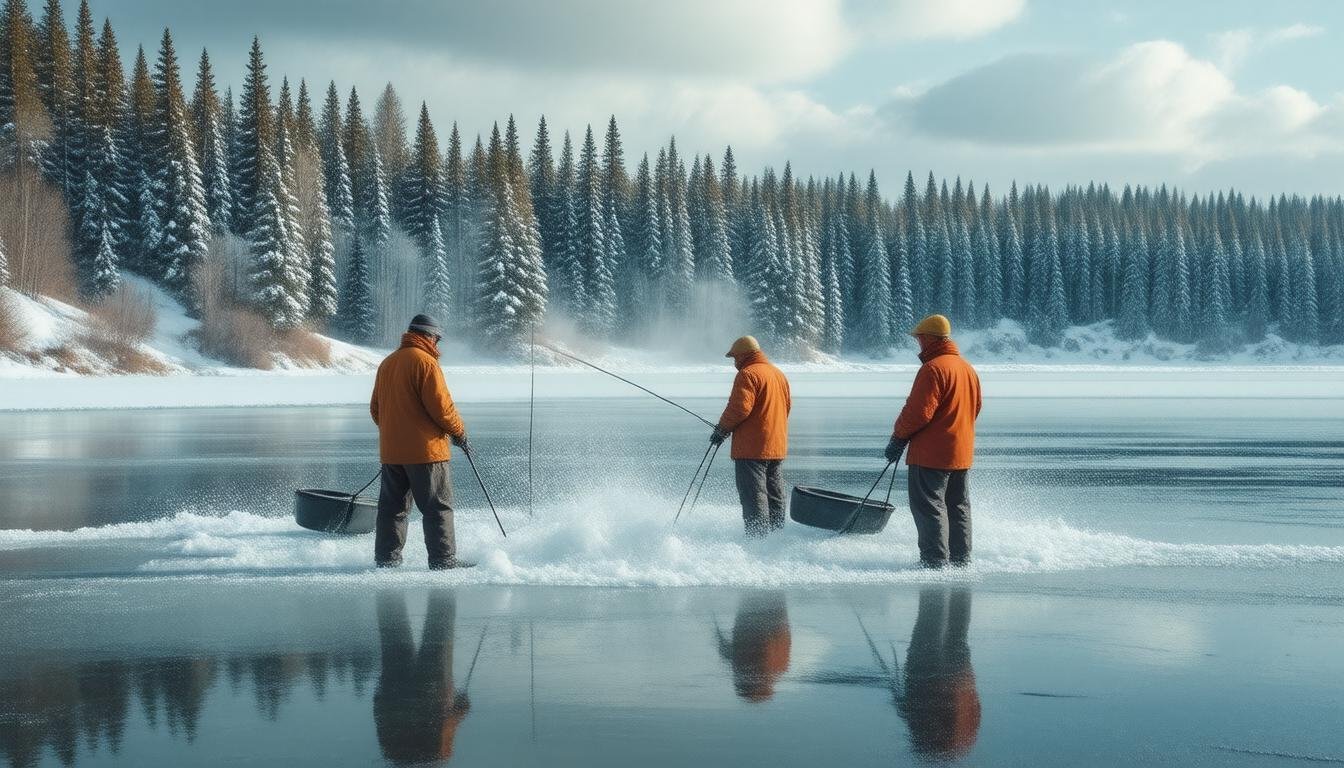You've made a clean shot, now it's time to track down your prey quickly and efficiently. Start by analyzing the animal's immediate reaction to determine the severity of the hit. Then, assess your shot placement to understand the wound's location and predict the blood trail signs. When following the trail, move slowly, crawl when necessary, and divide the area into a grid pattern to facilitate thorough coverage. Remember to stay focused, adaptable, and respectful of the animal's life. As you navigate the tracking process, stay tuned for expert tips on overcoming challenges and making a successful recovery.
Key Takeaways
- Conduct a Shot Angle Analysis to understand the bullet's trajectory and identify which essential organs were hit, informing tracking strategy.
- Analyze the blood trail's characteristics, including color, amount, and contents, to determine the wound's location and severity.
- Follow the blood trail slowly and deliberately, crawling when necessary, and divide the area into a grid pattern to cover each square.
- Adapt to changing circumstances, such as inclement weather or dense vegetation, and adjust the tracking strategy as new signs emerge.
- Prioritize a quick and humane recovery, adhering to hunting ethics and respecting the animal's life, to ensure a successful and respectful hunt.
Preparing for the Blood Trail
As you replay the events leading up to the shot, take a moment to mentally prepare yourself for the task ahead, recalling details about the hit, including the animal's reaction, shot placement, and potential wound location. Take a deep breath, and visualize the scene to get a clear understanding of what happened. This mental preparation is vital in setting yourself up for success. Next, double-check your gear checklist to make certain you have everything you need for the task ahead. This includes essential items like a compass, rangefinder, and surveyor's tape. Having the right equipment will help you stay focused on the task at hand. With a clear mind and the right gear, you're ready to begin tracking your prey.
Analyzing the Animal's Reaction
When the trigger is pulled, the animal's immediate reaction can reveal a wealth of information about the severity of the hit, so pay close attention to how it responds in the seconds and minutes following the shot. A wounded animal will often exhibit anxious behavior, such as rapid breathing, frantic movements, or erratic running. Pay attention to vocal cues like grunting, snorting, or bleating, which can indicate the severity of the wound. If the animal drops its head, lies down, or shows signs of weakness, it may be a good indication of a fatal hit. Observe the animal's posture, gait, and overall demeanor to gauge the effectiveness of the shot. By analyzing the animal's reaction, you can make an informed decision about when to begin tracking and increase your chances of a successful recovery.
Understanding Shot Placement
Now that you've analyzed the animal's reaction, it's time to examine the shot placement that led to that reaction, as the location and severity of the hit will greatly impact your tracking strategy. You need to determine the shot angle and identify which essential organs were hit. Conduct a Shot Angle Analysis to understand the bullet's trajectory and potential wound location. Identify if the shot was quartering, broadside, or at an angle. Organ Identification is paramount, as it'll help you predict the blood trail signs and the animal's behavior. Did you hit the lungs, liver, or heart? Knowing this will help you anticipate the animal's reaction and plan your tracking strategy accordingly.
Reading Blood Trail Signs
You'll quickly learn to identify the severity of the wound by recognizing the characteristics of the blood trail, which will greatly influence your tracking strategy. As you examine the blood trail, look for patterns and clues that reveal the wound's location and severity. Bright, pinkish blood indicates a lung or lung/heart hit, while crimson-colored blood suggests a muscle wound. Blood with foam or bubbles points to a lung hit, and small chunks of bone and crimson blood indicate a non-fatal muscle hit. By recognizing these signs, you'll better understand the animal's condition and adjust your tracking pace accordingly. Pay attention to the blood trail's color, amount, and contents to make informed decisions about your next move.
Following the Blood Trail
With rifle or bow still in hand, follow the blood trail carefully, taking note of the color, amount, and contents of the blood, as this crucial step will ultimately lead you to your harvested animal. As you track, keep an eye out for subtle signs like hair or bone fragments near the blood trail. Be patient and persistent, as the trail may lead you on a wild goose chase.
| Trail Navigation Techniques | Blood Trail Patterns |
|---|---|
| Follow the blood trail slowly and deliberately | Bright, pinkish blood indicates a lung or lung/heart hit |
| Crawl when necessary to bring eyes closer to the ground | Crimson-colored blood indicates a muscle wound |
| Divide the area into a grid pattern and cover each square | Blood with foam or bubbles indicates a lung hit |
| Walk in a crouched position to bring eyes closer to the ground | Small chunks of bone and crimson blood indicate a non-fatal muscle hit |
| Keep the nose in the game, as many bears and rutty bucks have been found by smell | Blood with grass or digestive material indicates a shot to the stomach or intestines |
Identifying Blood Characteristics
As you carefully follow the blood trail, it's time to examine the blood itself, paying attention to its color, consistency, and contents, which will provide essential clues about the severity of the wound and the animal's fate. You'll encounter different blood types, each revealing valuable information. Bright, pinkish blood often indicates a lung or lung/heart hit, while crimson-colored blood suggests a muscle wound. Note the consistency, too – thick, clotted blood may indicate a slower bleed, while thin, watery blood could mean a faster bleed. Clot formation can also provide important clues, as it can indicate the wound's severity and the animal's ability to move. By analyzing these characteristics, you'll gain a better understanding of your quarry's condition and increase your chances of a successful recovery.
Tracking the Wounded Animal
Carefully following the blood trail, you're now tasked with tracking the wounded animal, requiring patience, persistence, and attention to detail to facilitate a successful recovery. Understanding wildlife habits is vital in this phase, as you must anticipate the animal's reaction to the wound and its natural instincts. As a responsible hunter, adhering to hunting ethics and making a quick and humane recovery a priority is vital. Keep in mind that a wounded animal may alter its behavior, so be prepared to adapt your tracking strategy accordingly. Stay focused, and remember that every minute counts in locating your prey. By combining your knowledge of blood trail signs with a deep respect for the animal and the environment, you'll be well on your way to a successful recovery.
Overcoming Tracking Challenges
When tracking a wounded animal, you'll inevitably face obstacles that can throw you off the trail, and it's crucial to anticipate and overcome these challenges to guarantee a successful recovery. You must be prepared to adapt to the wounded animal's behavior, which can be unpredictable and erratic. Be aware that a wounded animal may alter its behavior to evade you, such as changing direction or speed. Tracking obstacles like inclement weather, dense vegetation, or difficult terrain can also hinder your progress. Stay focused and persistent, and don't let these challenges discourage you. Keep in mind that a wounded animal will often try to find a secure location to rest or hide, so be prepared to search thoroughly and methodically.
Adapting to Changing Circumstances
You must stay flexible and prepared to adjust your tracking strategy as new signs and clues emerge, and the blood trail's twists and turns demand a willingness to adapt to changing circumstances. As you follow the blood trail, be prepared to shift your approach when the signs don't match your initial expectations. Changing habits, such as the animal's behavior, and adapting strategies mid-track are essential to staying on the right path. Don't get stuck in your initial assessment; instead, remain open to new information and adjust your approach accordingly. This flexibility will help you stay hot on the trail and increase your chances of recovering your prey.
Recovering the Downed Animal
After finally closing in on the downed animal, take a moment to prepare yourself for the recovery process, making sure you have the necessary gear and a solid plan in place to guarantee a safe and respectful handling of the animal. Have a sharp knife and a means to transport the animal. Once you've confirmed the animal is deceased, begin the field dressing process, taking care to avoid contaminating the meat. Proper meat preservation is vital, so prioritize keeping the carcass cool and clean. Remember, as a hunter, you have a responsibility to uphold hunting ethics, respecting the animal's life and making certain its meat is utilized to the fullest.
Essential Gear for Tracking Success
With your mental preparation and planning in place, it's time to gear up with the right equipment to increase your chances of tracking success. You'll need gear that'll help you navigate the trail, identify signs, and stay comfortable during the process.
- Trail Navigation Tools: A compass, GPS device, or rangefinder will help you mark locations, track directions, and measure distances.
- Gear Essentials: Bring a first-aid kit, water, snacks, and a multi-tool or pocket knife to safeguard you against any situation.
- Observation Aids: A magnifying glass or handheld scope can help you examine signs and tracks up close.
Frequently Asked Questions
What if I Lose the Blood Trail in Dense Vegetation or Water?
When you lose the blood trail in dense vegetation, try adjusting your angle, using Vegetation Tactics like crawling low and slow, and searching for small signs. In water, look for Water Sign like ripples, bubbles, or displaced plants.
How Do I Track an Animal That Has Been Spooked by Other Hunters?
When tracking a spooked animal, consider the impact of hunter pressure; adapt your approach by reading signs of spooked behavior, such as rapid movement or altered routes, to stay on the animal's trail.
Can I Use Drones or Aerial Surveillance to Locate Wounded Animals?
You can use drones or aerial surveillance to locate wounded animals, but verify you comply with Drone Regulations and consider Aerial Scouting ethics; however, traditional tracking skills are still essential for a successful recovery.
What if I'm Tracking Alone and Need to Mark My Own Trail Back?
When tracking alone, mark your own trail back with trail markers like flagging tape or reflective tacks, ensuring solo navigation by leaving a visible path to follow, especially in dense or unfamiliar terrain.
Are There Specific Blood Trail Signs for Different Species of Game Animals?
When tracking different species, you'll notice distinct blood trail signs; for example, deer often leave a scattered, speckled pattern, while elk and moose tend to produce a more profuse, crimson flow, highlighting the importance of blood pattern analysis and understanding species-specific hemorrhaging.
Conclusion
You've traversed the wilderness, tracking the twists and turns of the blood trail like a modern-day Sherlock Holmes. The game's afoot, and you've solved the mystery, staying hot on the heels of your prey. As you finally close in, the thrill of the hunt culminates in a sense of pride and satisfaction. You've proven yourself a worthy adversary, outsmarting and outmaneuvering your quarry. Now, stand victorious, knowing your perseverance and skill have earned you the ultimate prize.








